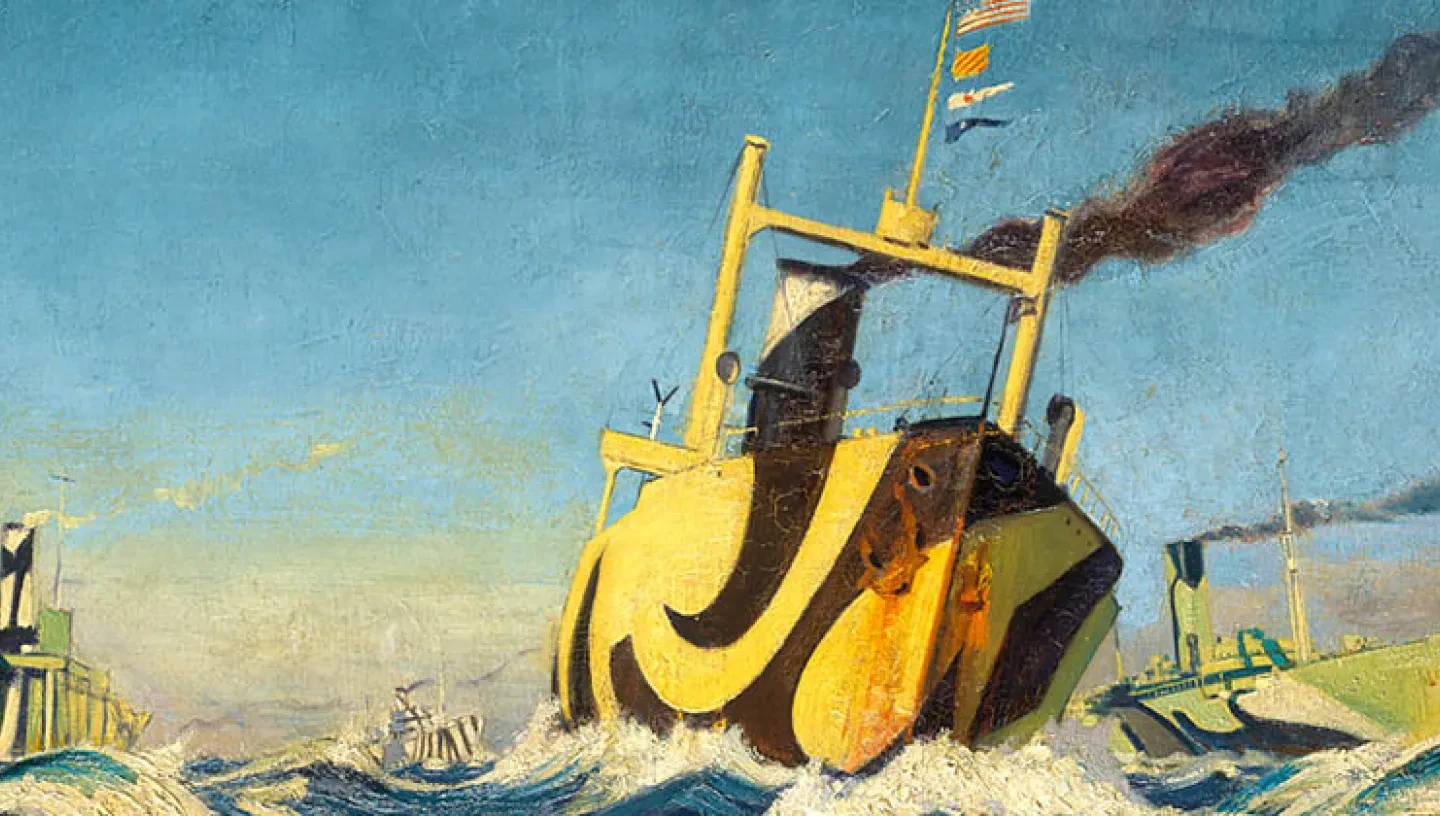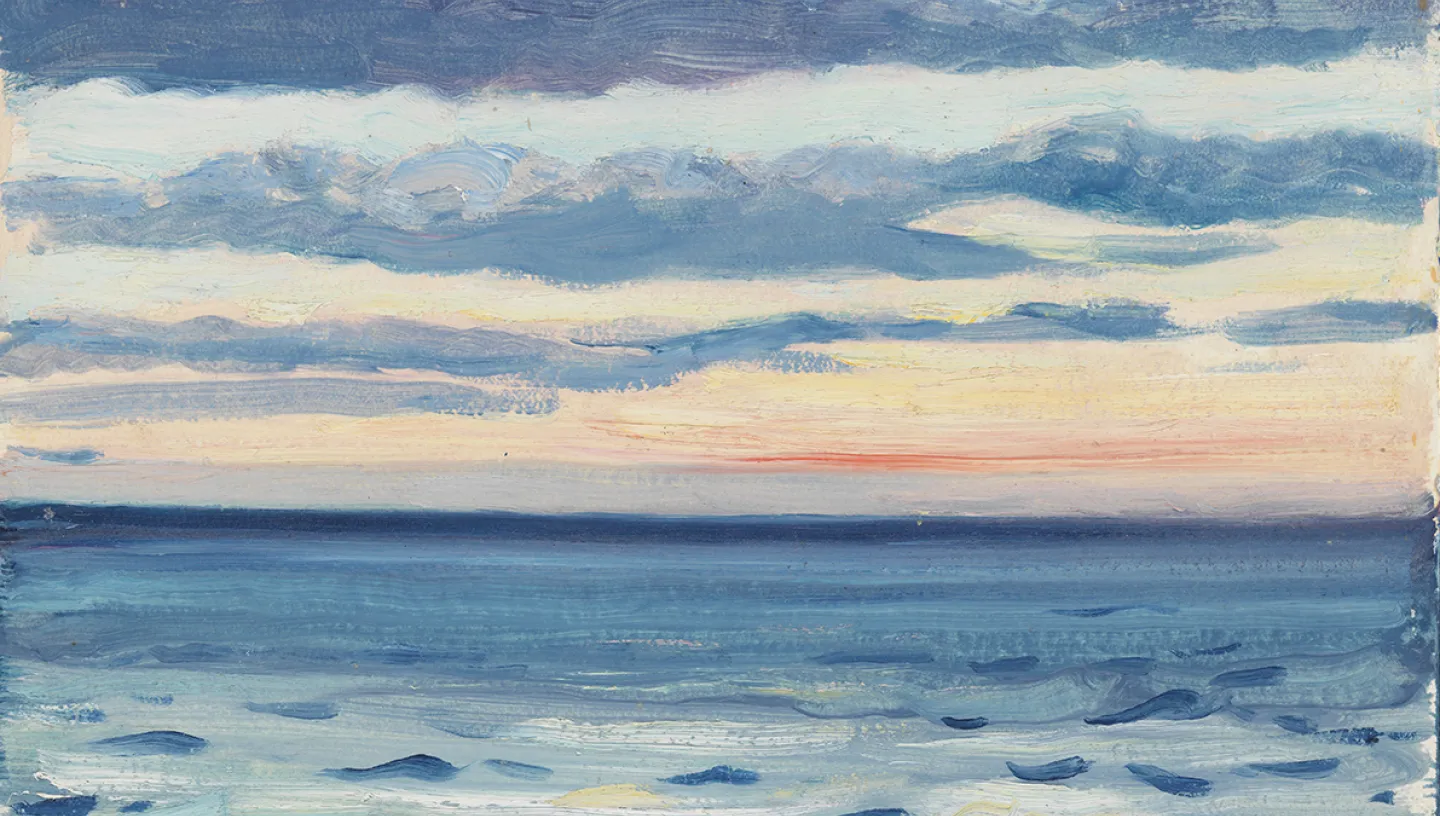
'Dazzle' was a type of camouflage developed in response to the threat of German U-boat submarines. First World War artist John Everett bequeathed practically his entire life’s work to the National Maritime Museum. The paintings now on display in the Queen’s House show his artistic response to wartime seafaring.
John Everett and the art of 'dazzle' camouflage
- John Everett’s 1,058 oil paintings form one of the nation’s largest collections by a single artist.
- Everett occupies a unique position in the canon of marine painting through a lifetime’s artistic response to the sea.
- He was commissioned by the Ministry of Information to make drawings and paintings of wartime London docks and the Thames, especially the visual effects of dazzle shipping.
- Everett’s marine work forms a unique record of an artist working on ships and painting at sea.
- He also worked on a series of heavily stylised pictures of Cutty Sark, which he had seen on several voyages.
- He lived through a time of enormous change – witnessing the first flight across the Channel in 1909, the ending of the commercial use of sailing ships, and two World Wars.
Who was John Everett?
John Everett (1876–1949) trained at the Slade School of Fine Art in London in the late 1890s, during which time he also developed a passion for seafaring. Fellow students included Augustus and Gwen John, and William Orpen, whose portrait of Everett is displayed in the Queen’s House. After his first sea voyage in 1898, Everett made marine painting his speciality.
Everett was at first unable to sketch outdoors due to wartime security regulations, but in the spring of 1918, the Ministry of Information asked him to depict London river scenes. Everett received a permit to draw, and that summer, spent every day at the docks.
As a practical sailor, Everett’s work reflects the knowledge he gained from living on board a ship. He was also a fine draughtsman, and saw his subject in terms of rhythmic designs and carefully structured composition. His detailed drawings not only display his interest for the powerful lines of modern ships, but also his understanding of harbour activities.
What was 'dazzle' camouflage?
What attracted him most were the ships covered in ‘dazzle painting’. Dazzle was a type of camouflage developed by the artist Norman Wilkinson in 1917, in response to the heavy losses sustained by British merchant ships to German U-boat submarines. This involved painting the sides and upper works of a ship in contrasting colours and shapes arranged in irregular zebra-like, angular patterns to create a distorted effect. This was designed to deceive enemy shipping about the size, outline, course and speed of a ship, since the consequent distortion made it impossible to assess speed and distance and therefore made attack problematic.
Where are Everett’s ‘dazzle’ paintings now?
Everett’s ‘dazzle’ pictures are among his most daring works for their sense of composition and modernity, but they remained unsold. Everett wrote in his unpublished memoirs:
‘The Ministry of Information went out of existence in Nov. 11th 1918. I could have sold all the works I did in the docks during the war. After the war, everybody was so fed up, they wouldn't look at any war thing. In Nov. I had a show of 50 things at the Goupil Gallery in Lower Regent Street. I only sold one, to H.G. Wells.’
The pictures stayed with Everett until they came to the Museum, and the selection now on display shows them as dazzling as they must have been when first seen.
John Everett paintings
A large and dramatic evocation of the bow of the 'Cutty Sark', showing a carved figurehead. In this highly stylized painting the ship is shown moving through the waves at sunset. The sails of the ship loom above the viewer's point of vision.
The figurehead represents a character from Robert Burns's poem 'Tam O'Shanter', which tells the story of a Scottish farmer who was chased by the young witch. Known as Nannie, she is shown wearing a short chemise, also called a cutty sark, from which the name of the ship was taken. The figurehead of Nannie was carved by master craftsman Robert Hellyer, of Blackwall.
Everett evokes the art deco in this highly stylized and formulaic painting. The crests of the waves are reduced to a series of white blocks on the horizon, reminiscent of Japanese prints. The sun, in thick impasto paint, glows orange on the horizon and the sails are outlined and painted as blocks of colour.
The main subject towards the right of the picture is a dazzle-painted Royal Naval Auxiliary tanker seen in starboard-quarter view, turning in the River Thames off Greenwich. She is towing a small boat with two men alongside. The Royal Naval College, a dazzle-painted ship and a ketch-rigged Thames barge are to the far left. Between them and the tanker is a picket boat with a yellow funnel, at the east end of the Pier, with another camouflaged ship to its right and the Royal Observatory visible on the hill above
This scene shows how modern and traditional vessels were anchored side by side in the docks. It also inspired a very formal response by Everett: a strong, colourful composition based on vertical lines. The grey structures of the grain silos at the centre are echoed by the dazzle-painted funnel of the ship on the left, and the rust-coloured sail of the small craft on the right, which stands out forcefully from the vivid blue sky.
John Everett painted and drew hundreds of sketches of the sea in oils, pastel and pencil.
In this interpretation the artist has concentrated on the quality of the movement of the waves and reduced it to a rhythmic form. The waves are presented in sculpted layers enforcing the sensation of movement. Their features are similar, so that there is the impression of continuity and relentlessness to their action. Although the waves are presented blue, there is considerable variation of tone within the work, and this brilliance of the colour contrasts with the white foam that rises vertically in a rhythm, reaching a crescendo on the far right. The foam on the surface of the wave in the foreground has created a honeycombed effect on the surface of the water. The wave behind is alternately honeycombed or streaked with white lines. The artist has demonstrated a strong emphasis on the significance of form, which hovers on abstraction.






